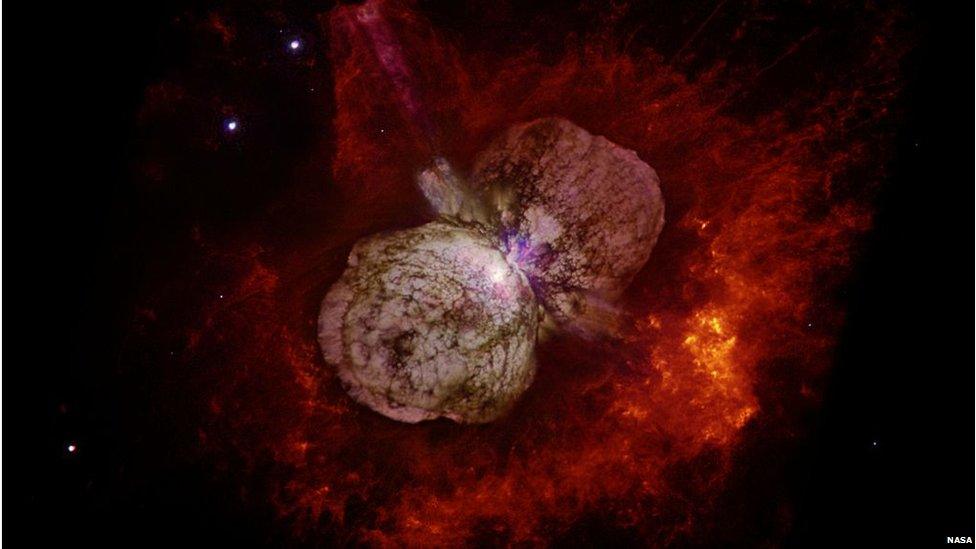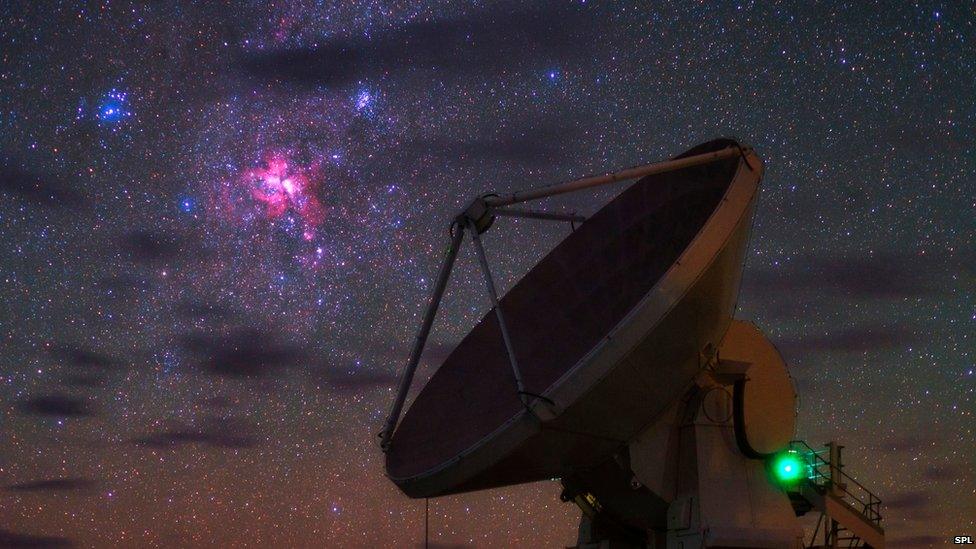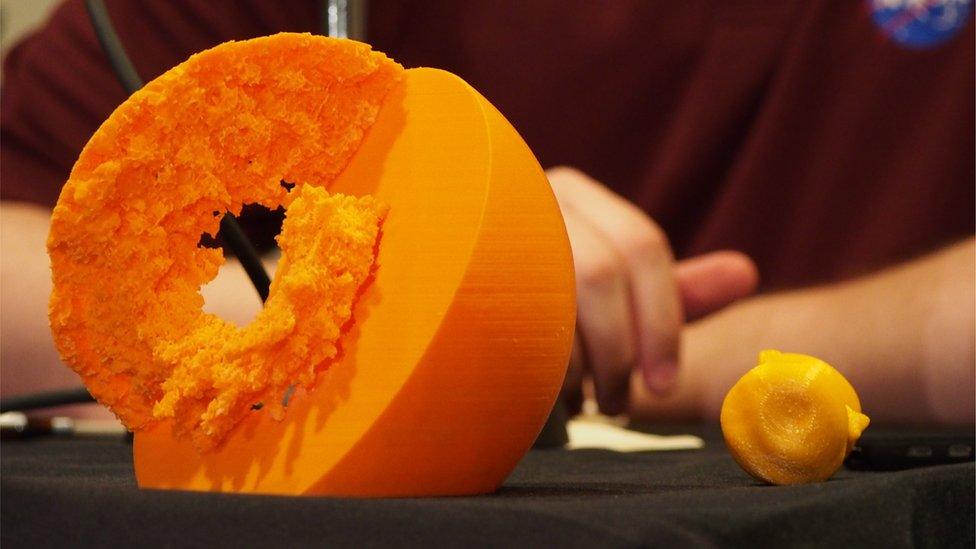Explosive stellar tussle revealed in 3D
- Published

An explosion seen from Earth in the 19th century created the huge lobes of the Homunculus Nebula, which now partially obscure the culpable superstar Eta Carinae
Astrophysicists studying the unstable "stellar monster" Eta Carinae have revealed new details and a 3D model of the destructive maelstrom at its heart.
Two giant stars are locked in orbit at the centre of an expanding hour-glass of matter they have spewed into space.
Every five years they swing closer together than Mars and our Sun, causing a spike in X-rays we can see on Earth.
A new model of the duelling stellar winds accounts for many of the fluctuations in the system's emissions.
The work, led by researchers at Nasa's Goddard Space Flight Center in Maryland, was presented at the American Astronomical Society's, external 225th meeting in Seattle.
Violent companions
Eta Carinae is 7,500 light years from Earth - and it is the biggest star within 10,000.
Astronomers have built a 3D model of the vast "stellar monster" Eta Carinae, where two suns are locked in an unstable, explosive tussle
It sits in the southern constellation Carina.
In the 1840s a dazzling eruption made it, for a time, the second brightest star in the sky - and gave birth to the Homunculus Nebula.
Enough gas to make ten Suns burst into a vast, two-lobed cloud of debris. The unfurling nebula is half a light-year across and still expanding.
The clouds obscure details of the bizarre star system at their centre, and shield much of its brilliance: more than five million times the intensity of our Sun.
Many years of observations from space and ground telescopes, as well as contributions from amateur astronomers, have helped scientists build up a much clearer picture of what is taking place.
Eta Carinae, itself at least 90 times the mass of our sun, has a companion star only about three times smaller.

Despite the vast intervening distance, the Carina Nebula is a bright feature in the southern sky
As they orbit each other in two mismatched ellipses, the two stars throw out vast amounts of gas in the form of "stellar winds".
Especially when the two stars get close together, their colliding winds produce fireworks that echo across space. That interaction is what physicists have now modelled in more detail than ever before.
In particular, a "bow shock" is produced as the smaller star ploughs through the denser wind of its partner.
It is quite a collision, explained the Goddard Center's Dr Michael Corcoran.
"You can imagine a six-million mile per hour object smacking in, and decelerating to zero quite rapidly. That would generate quite a lot of energy," he told journalists at the conference.
That energy heats up the gases and generates X-rays.
A repeating pattern in these X-rays, dubbed the "Eta clock", has allowed scientists to pinpoint the stars' orbital period at five-and-a-half years.
"What we think is happening is, as the stars approach each other... the X-rays brighten because the winds get more dense," Dr Corcoran said.
Fingers of fire
Another team has been monitoring the fluctuations in a different kind of light - a blue colour emitted by helium atoms.
With the help of amateur astronomers spanning the Southern Hemisphere, Dr Mairan Teodoro from Western Michigan University has tracked the rise and fall of this light over three orbital cycles.
The blue wavelength is thought to come from the primary star's side of the colliding winds. He explained that outside the repeating five-year cycle, there appears to be little long-term change - unlike the X-ray emissions, which seem to be changing as the stars continue to lose mass.

The team unveiled 3D-printed freeze-frames from their simulation of the colliding stellar winds
Meanwhile Dr Tom Madura, also of the Goddard Center, has used many of these detailed observations of Eta Carinae to construct a supercomputer simulation of the interacting stars.
It reveals a dramatic, spiralling effect as the stars reach their closest point (called the "periastron").
To better understand this shape, Dr Madura used a 3D printer to make a physical copy of the ragged border between the two stellar winds, frozen at three different time points.
These printed models, unveiled at the conference, include striking finger-like projections that even surprised the researchers themselves.
"These are features that we didn't even know existed," Dr Madura said, adding that the wind-fingers may arise because the two opposing blasts are very different.
"You have this really fast wind from the secondary star, colliding with what's essentially a wall of gas," he said, comparing the interaction to that of water and vinegar.
The team also made 3D printing files for the shape of the iconic nebula. These have proved popular online.
"We've had 100,000 downloads," said Goddard Center astrophysicist Dr Ted Gull.
Asked about the much-discussed possibility of Eta Carinae exploding into a supernova, Dr Gull said it would brighten our night sky in the south, rather than wipe us out.
"It's going to be a source of daylight comparable to the moon - but a point source," he told the BBC.
As for when the star will blow: "We have no idea. We have no clue!"
But blow it will, Dr Gull said. "Some time in the next few hundred thousand years."
For a violently unstable stellar monstrosity, he added, "it seems pretty stable right now."
"And in the meantime, it's a wonderful laboratory."
- Published8 February 2012
- Published8 February 2012
